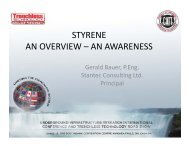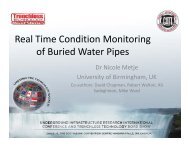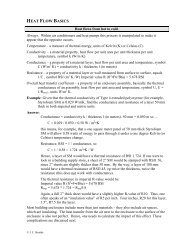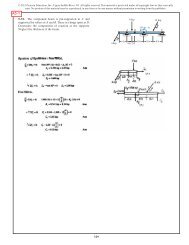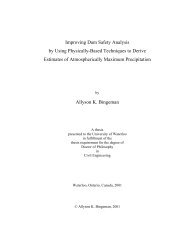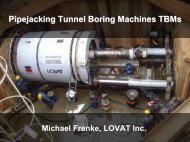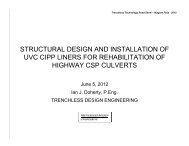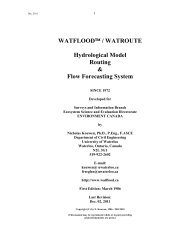Planning Horizontal Directional Drilling for Pipeline Construction
Planning Horizontal Directional Drilling for Pipeline Construction
Planning Horizontal Directional Drilling for Pipeline Construction
You also want an ePaper? Increase the reach of your titles
YUMPU automatically turns print PDFs into web optimized ePapers that Google loves.
1.2.2 <strong>Drilling</strong> the Pilot Hole<br />
An HDD drill rig and supporting equipment are set-up at the drill entry location<br />
determined during the pre-site planning phase.<br />
A pilot hole is drilled along the predetermined drill path.<br />
Periodic readings from a probe situated close to the drill bit are used to determine<br />
the horizontal and vertical coordinates along the pilot hole in relation to the initial<br />
entry point; the pilot hole path may also be tracked using a surface monitoring<br />
system that determines the down hole probe location by taking measurements<br />
from a surface point.<br />
<strong>Drilling</strong> fluid is injected under pressure ahead of the drill bit to provide hydraulic<br />
power to the down hole mud motor (if used), transport drill cuttings to the surface,<br />
clean build-up on the drill bit, cool the drill bit, reduce the friction between the<br />
drill and bore wall, and stabilize the bore hole.<br />
1.2.3 Reaming of the Pilot Hole<br />
The down hole assembly is removed from the drill string upon breaking the<br />
ground surface at the exit location and is replaced with a back reamer;<br />
The drill string is pulled back through the bore hole and the back reamer enlarges<br />
the diameter of the drill hole;<br />
The reamer may be pulled from the pipe side of the HDD crossing if additional<br />
passes with the reamer are required to achieve the desired bore hole diameter; and<br />
The reaming stage may not be necessary during HDDs <strong>for</strong> small diameter<br />
pipelines where the bore hole created by the pilot hole drill is of adequate size to<br />
pull back the pipe string (refer to Section 8.5.1).<br />
1.2.4 Pipe String Pull back<br />
Pipe is welded into a pipe string or drag section, that is slightly longer than the<br />
length of the drill, on the exit side of the bore hole.<br />
The pipe is typically coated with a corrosion and abrasion resistant covering, and<br />
is commonly hydrostatically pretested to ensure pipeline integrity.<br />
The pipe string is pulled over rollers into the exit hole and the pull back continues<br />
until the entire pipe string has been pulled into the bore hole.<br />
The external coating of the pipe string visible at the entry point is inspected <strong>for</strong><br />
damage upon completion of the pull back.<br />
September 2004 <strong>Planning</strong> <strong>Horizontal</strong> <strong>Directional</strong> <strong>Drilling</strong> <strong>for</strong> <strong>Pipeline</strong> <strong>Construction</strong> Page 1-4



